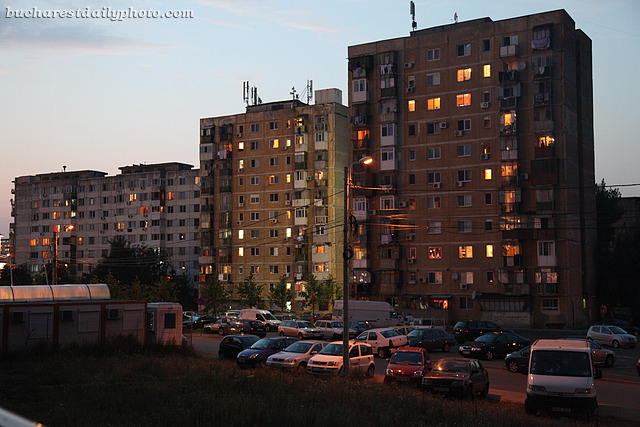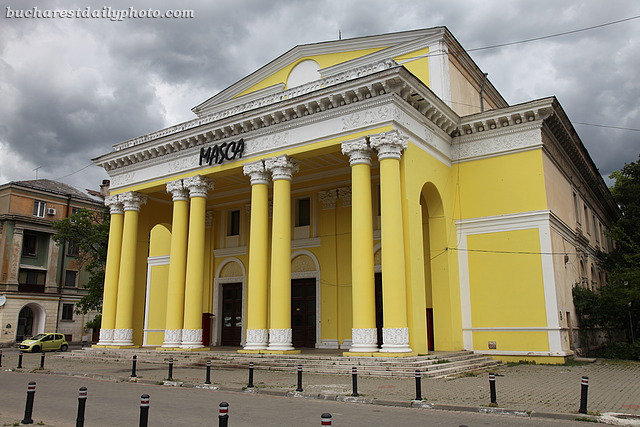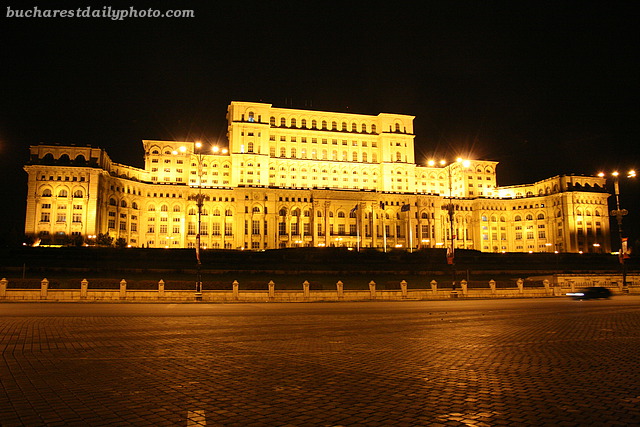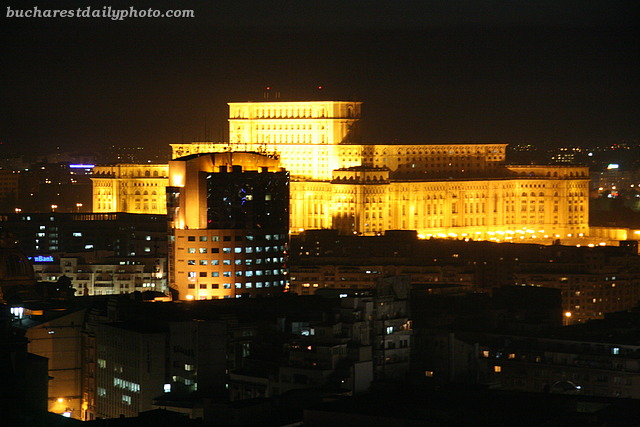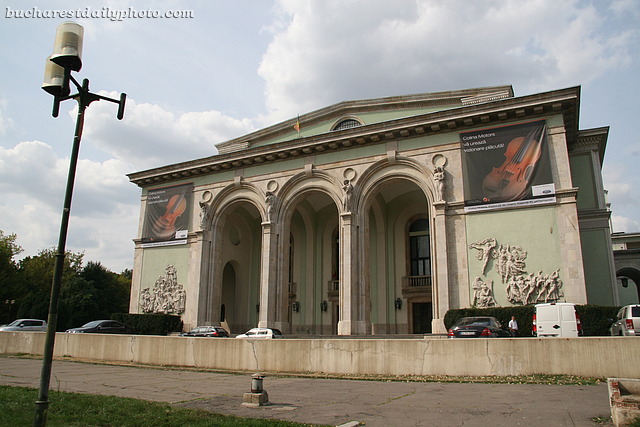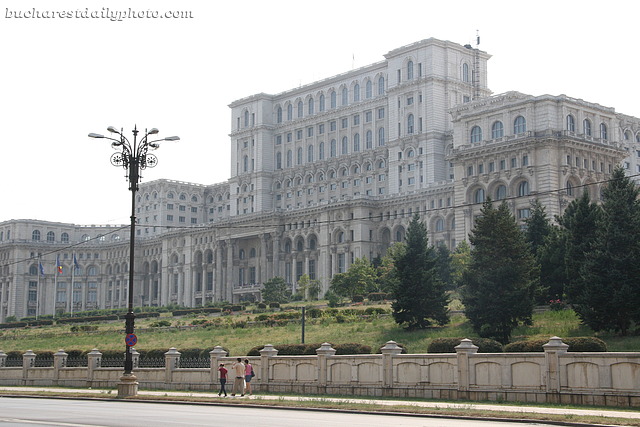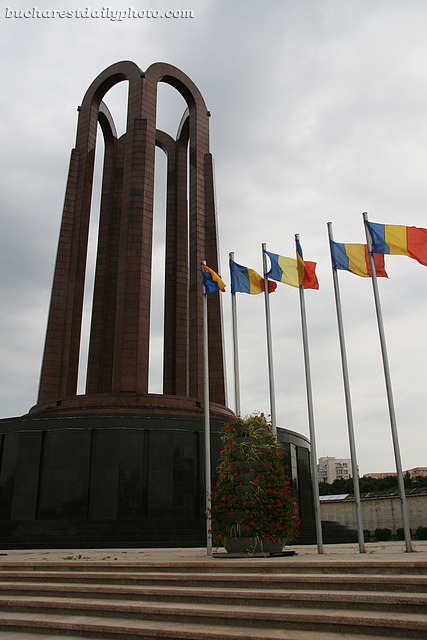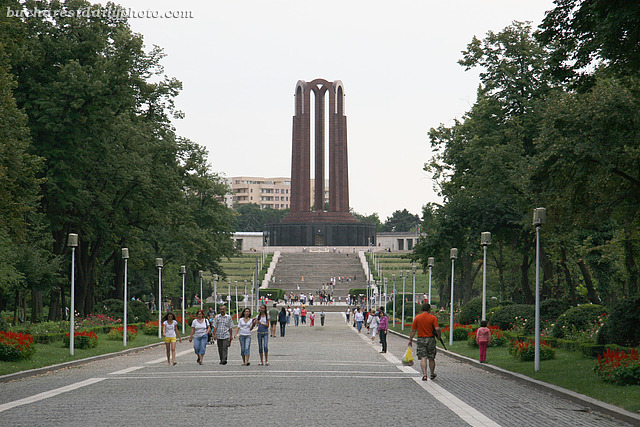I guess I don’t have to say it, it’s rather obvious. I’m back 🙂
Despite its classical look, the theater building featured in today’s photo is actually not that old. Its former name should give away its approximate age. Until 20 years ago it was called “The Unity Among People Cultural House”. Does that ring a bell? 🙂 It was build in 1953, during the first years of the communism regime, by architect Nicolae Porumbescu. These were the first years of communism in Romania and the style condoned by the regime was called “socialist realism“, the official artistic movement of the Soviet Union. The socialist realism required an artificial return to the classical theme, away from the modernist tendencies of the day. After the 1989 revolution the theater housed “The Mask” theater company (Teatrul Masca in Romanian) which later moved to another venue while this one is awaiting renovation (for quite some time now, but than I guess it’s not easy to gather the money to renovate it).
I’m still trying to come to peace with this cold giant who became a symbol of Bucharest. To me the Palace of Parliament will always be a glimpse into Romania’s communist past. Here it is for you (again): surreal in size and probably consuming as much electricity as 100 villages.
For today the (in)famous Palace of Parliament looming over the city’s skyline. The building that partially blocks the view is the tower of Bucharest Financial Plaza.
Bucharest’s Opera House is the main venue for seeing opera and ballet performances in Bucharest. Their annual season runs from October to June and tickets are usually dirt cheap, a far cry from tickets to Madonna’s concert 🙂 They tend to stick to a classical repertoire. Due to lack of funding the sets are not too spectacular but performances are of a high quality. The edifice was built in the years 1952-1953 after the design by a group of architects led by Octav Doicescu. These were the first years of communism in Romania and the style condoned by the regime was called “socialist realism“, the official artistic movement of the Soviet Union. The socialist realism required an artificial return to the classical theme, away from the modernist tendencies of the day, which is why the Opera building has a neoclassical design. One example of the socialist realism touch, that can be seen in the photo, are the bas reliefs on the facade. The interior is in the tradition of the 18th century Italian Opera, with a central dome and three tiers of balconies. It can seat 1200 people. The inauguration of the new building of the Opera House was celebrated by a performance of Tchaikovsky’s Queen of Spades on January 9th, 1954 followed by the ballet Coppelia the following night.
This is the first time I’m taking part in Theme Day of the City Daily Photo community. Theme Day is a monthly event that happens the first day of every month, when all participating blogs will post a picture that relates to the theme day’s description. Today’s theme is Big. Click here to view thumbnails for all participants
I decided for a straighforward treatment of this theme and just photographed the biggest thing I could find in my city. I don’t know if you’ve heard but Bucharest holds the dubious record of having the biggest Parliament building in the world, which is also the second largest administrative building in the world after the Pentagon. It truly is as big as a dictator’s ego. Bucharest’s Palace of Parliament was built during the Ceauşescu’s regime and it was designed as the seat of his political power. He also intended to use the building as his personal residence. Construction began in 1984 and at the time of Ceauşescu’s death in 1989 it was not completely finished. He never got to move in.
The Palace of Parliament was and still is a controversial building. Some people think of it as shameful, an architectural horror while others are proud of its records and consider it the biggest tourist attraction in Bucharest. I tend to side with those who don’t like the building, which in my eyes represents the peak of Ceausescu’s megalomania. Many old beautiful buildings were demolished to make way for this pointlessly massive “house” (Parliament’s Palace used to be called The House of the People during the communist regime). To quote wikipedia, “much of Bucharest’s historic district, including 19 Orthodox Christian churches, six Jewish synagogues, three Protestant churches (plus eight relocated churches), and 30,000 residences” were demolished to create the space necessary for this project. I remember a joke that was going around at the time: the boulevard that ends with the Parliament Palace was to be called “The Victory of Socialism”. The joke’s punchline was that in fact the name of the boulevard is “The Victory of Socialism against Bucharest”.
Unfortunatelly I read somewhere that this building is indeed the biggest tourist attraction in Bucharest. Seems like people like records of this sort. I visited the building once, when they opened it for public in 1990; I remember some huge rooms, the dimensions being so excessive that nothing else was noticeable. Today the building houses the Romanian Parliament, as well as the National Museum of Contemporary Art (MNAC) opened in 2004 inside the west wing. It can be visited by guided tours.
And another (more patriotic) shot of the mausoleum.
What does a citizen of Bucharest do if it’s nice outside and it’s a Sunday? A lot of them are heading for one of the city’s parks to chill in the shade on a wooden bench, talk to friends, play some volleyball, walk hand in hand with their sweethearts, play with other kids (if we’re talking about the little citizens), listen conversations of their neighbourgs, watch the old people play chess, rent a boat, check out other people’s outfits, drink a beer if there’s a beer garden nearby (there always is one), take pictures (like myself), rollerblade or ride the bicycle, jogg, walk the dog (if it’s allowed), feed the geese or swans or ducks, smell the flowers etc. Today’s photo shows the central alley in Carol Park on a Sunday. And as an added bonus, aside from the greenery and the people, there’s something else for you to enjoy in the picture: a piece of communist architecture, the mausoleum built in the honor of … hold your breath … “the heroes who fought for the freedom of the people and of the motherland and for socialism”. You can breathe now. I’m not kidding, that was the name of the monument during the communist regime. It was built in 1963 and until 1991 it housed the remains of many communist leaders. Nowadays the mausoleum contains the remains of soldiers fallen in WWI and has been dedicated to the Unknown Soldier. In front of it there’s a small monument flanked by guards where an eternal flame is burning.
